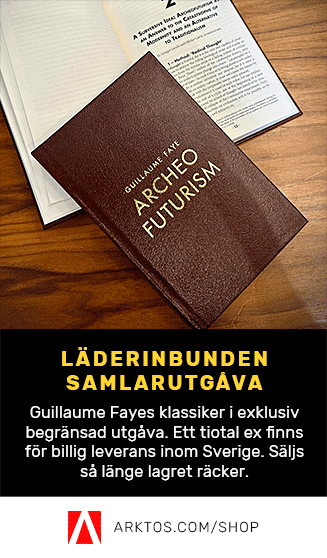Det händer att man använder uttrycket Lykantropernas Revolt för att beskriva den djupt arkaiska och europeiska strömning som på det politiska planet kommer till uttryck genom européernas återuppvaknande och försvar av sitt urhem och sina folkfränder. Inte sällan används liknelser med vargar och varulvar av både företrädare för och motståndare till detta fenomen, och den liknelsen är välfunnen. Denna revolt är nämligen i själva verket en kreativ atavism, och vargen är en uråldrig indo-europeisk arketyp som ständigt finns inom oss som en möjlighet.
Vetenskapsmän som studerat våra indo-europeiska förfäder upptäckte tidigt att centralt i deras förhistoria var det som kallats Männerbund, alltså mannaförbund av krigare och mystiker. Det har rentav påståtts att det var sådana förbund som skapade de första indo-europeiska staterna, och att sagorna om bärsärkarna, kentaurerna, Romulus’ krigarband eller de indiska ghandarvas var ett eko av dem. Dessa krigarförbund hade ett särskilt förhållande tillolika djur, och då inte minst vargen.
Geto-Dacerna, ett indo-europeiskt vargfolk
Den rumänske forskaren Mircea Eliade studerar i sin bok Zalmoxis, the Vanishing God bland annat sådana fenomen. En del av boken har publicerats på internetsidan Dacians the Wolf-People.
Vi läser där att en mängd indo-europeiska folk hade vargen som sitt djur. Hos många gick det så långt att de fick sitt etniska namn från vargen, såsom dacerna (daoi ska betyda varg enligt texten), de iranska hyrkanerna (från varkha, varg), de italiska hirpi sorani (Soras vargar), med flera. Hirpi Sorani hade av ett orakel råtts att ”leva som vargar”, vilket de också gjorde.
Texten fortsätter därefter med att beskriva Männerbund-fenomenet, och är värd att citera rakt av där:
Now the essential part of the military initiation consisted in ritually transforming the young warrior into some species of predatory wild animal. It was not solely a matter of courage, physical strength, or endurance, but ”of a magico-religious experience that radically changed the young warriors mode of being. He had to transmute his humanity by an access of aggressive and terrifying fury that made him like a raging carnivore.” Among the ancient Germans the predator-warriors were called berserkir, literally ”warriors in the body-covering [serkrj] of a bear.” They were also known as itqkedhnar, ”wolf-skin men.” The bronze plaque from Torslunda shows a warrior disguised as a wolf. From all this, two facts emerge:
1. A young man became a redoubtable warrior by magically assimilating the behavior of a carnivore, especially a wolf;
2. He ritually donned the wolf-skin, either to share in the mode of being of a carnivore or to indicate that he had become a ”wolf.”
What is important for our investigation is the fact that the young warrior accomplished his transformation into a wolf by the ritual donning of a wolf-skin, an operation preceded or followed by a radical change in behavior. As long as he was wrapped in the animal’s skin, he ceased to be a man, he was the carnivore itself: not only was he a ferocious and invincible warrior, possessed by the furor heroicus, he had cast off all humanity; in short, he no longer felt bound by the laws and customs of men. And in fact young warriors, not satisfied with claiming the right to commit rapine and terrorize the community during their ritual meetings, were able to behave like carnivores in eating, for example, human flesh. Beliefs in ritual or ecstatic lycanthropy are documented both among the members of North American and African secret societies and among the Germans, the Greeks, the Iranians, and the Indians. That there were actual instances of anthropophagic lycanthropy there is no reason whatever to doubt. The so-called leopard societies of Africa furnish the best example. But such sporadic cases of ”lycanthropy” cannot account for the dissemination and persistence of beliefs in ”wolf-men.” On the contrary, it is the existence of brotherhoods of young warriors, or of magicians, who, whether or not they wear wolf-skins, behave like carnivores, that explains the dissemination of beliefs in lycanthropy.
The Iranian texts several times mention ”two-pawed wolves,” that is, members of the Mönnerbünde. The Dënkart even states that ”two-pawed wolves” are ”more deadly than wolves with fbur paws.” Other texts term them keresa, ”brigands, prowlers,” who move about at night. The texts dwell on the fact that these ”wolves live on corpses; however, without excluding the possibility of actual cannibalism, this would seem to be more in the nature of a stereotype used by Zarathustran polemicists against the members of the Männerbünde, who, in practicing their ceremonies, terrorized the villages and whose way of life was so different from that of the Iranian peasants and herders. In any case, mention is also made of their ecstatic orgies, that is, of the intoxicating drink that helped them to change into wild beasts. Among the ancestors of the Achaemenides there was also a family named saka haumavarka. Bartholomae and Wikander interpret the name: ”those who change themselves into wolves (varka) in the ecstasy brought on by soma (hauma).” Now we know that down to the nineteenth century assemblies of young men included a banquet of food and drink stolen or obtained by force, especially alcoholic beverages.
Vi ser alltså att lykantroparketypen är djupt rotad i den indo-europeiska krigarkasten, och det är därför heller ingen överraskning att den dyker upp i de tider då folket hotas.

Dacians the Wolfpeople kan läsas här:
http://www.angelfire.com/in/cih/dacians.html
http://forum.skadi.net/showthread.php?t=57218
Mer om Mannaförbund och ghandarvas har skrivits på bloggen här:
http://oskorei.webblogg.se/160406085321_roms_kungatid.html
http://oskorei.webblogg.se/110106170422_dumezils_mitravaruna.html
http://oskorei.webblogg.se/230206202204_indoeuropeiska_brsrkar.html
För den lässugne, mer om Dumezil och även funderingar kring en fjärde funktion hos indo-européerna (en ”Loke-funktion” ;-):
http://departments.oxy.edu/anthropology/field/wall.html













